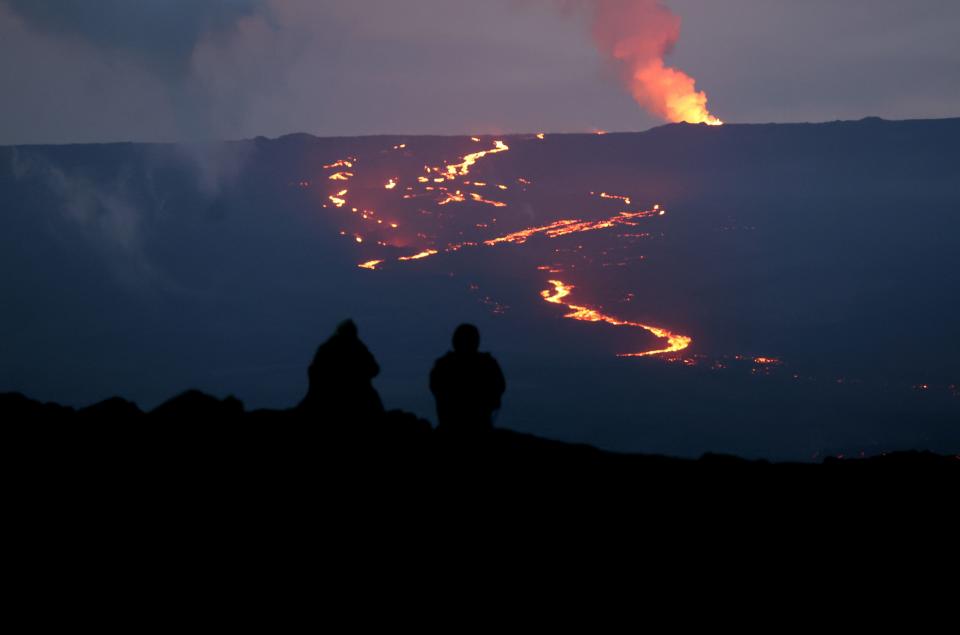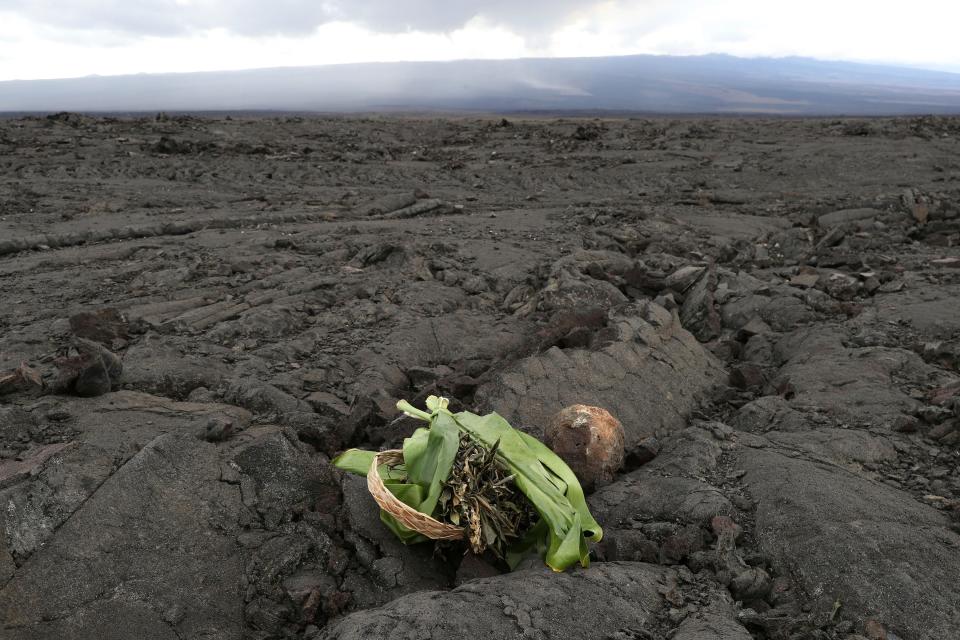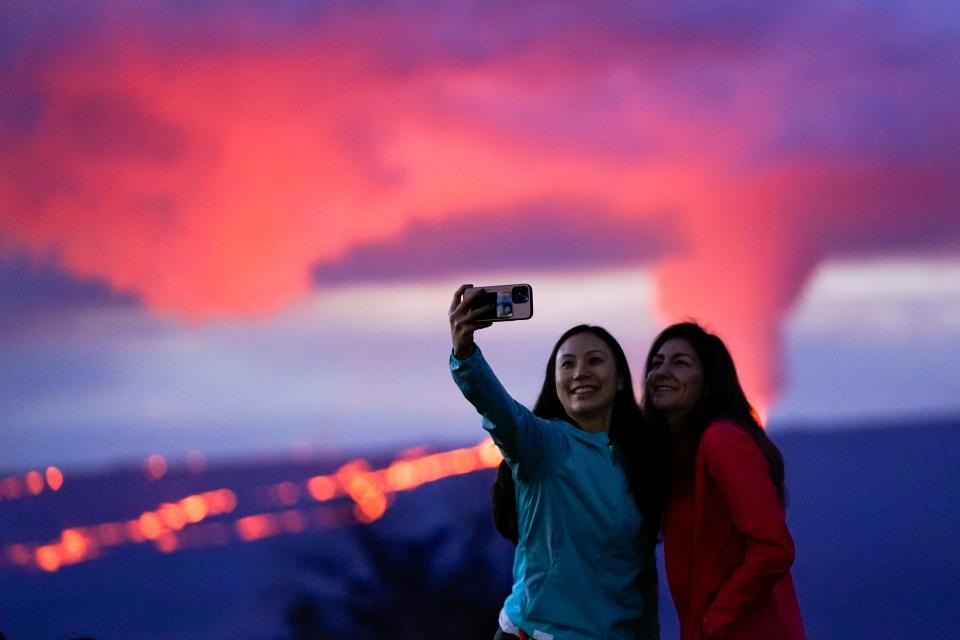Native Hawaiians find a spiritual connection to Mauna Loa eruption: 'Our deities are alive and well'
HONOLULU – When Hawaii Island resident Kū Kahakalau heard Mauna Loa was erupting right before midnight on Nov. 27, she said she felt excited.
"It's always exciting when Tūtū Pele is on the move," the Native Hawaiian educator, activist and researcher told USA TODAY. "It reminds us that our deities are alive and well – that they're here and they exist."
The event was "very exciting and very revered and very precious to us," she said.
In Hawaiian culture, natural forces are manifestations of gods and goddesses, or akua. Pele is the goddess of volcanoes and has a passionate temperament. According to moʻolelo (stories), Pele lives in the Halemaʻumaʻu crater located at the summit of Kīlauea in Hawaii Volcanoes National Park. In the form of volcanic activity, she and her work represent rebirth and resetting, the way lava cools into new, refreshed land.
The lava flowed until Tuesday when U.S. Geological Survey scientists announced that Mauna Loa and its fellow, smaller active volcano Kīlauea have stopped erupting.
During that time, many Native Hawaiians visited the lava to chant (oli), pray or leave hoʻokupu (offerings) in honor of the goddess.

Kahakalau is one of many Native Hawaiians who found the latest Mauna Loa eruption to be culturally significant – it was a sign of a greater spiritual force at play, that their akua are alive and showing up for a reason. The eruption also provided a moment of reflection on their identity and living in harmony with nature.
What does Mauna Loa's eruption mean?
To many people, visiting Hawaii Volcanoes National Park tops their Hawaii travel bucket lists. To Native Hawaiians, the landscape that makes up the national park is sacred.
Haleakala: America's newest National Park Service site tells a different segregation story
"For Hawaiians, we see ourselves as part of this Earth. We were born from this land, our land is our mother and the sky is our father," Healani Sonoda-Pale, a Native Hawaiian educator and activist with Ka Lāhui Hawaiʻi Political Action Committee, told USA TODAY. "The natural world is something we need to take care of and live in harmony with."
The eruption was spiritual to Sonoda-Pale, whose family is from Hawaii Island. "We see this as a manifestation of the goddess Pele who is also an ancestor to our people and as her taking back the 'aina that never really belonged to us," she said. "It's about cleaning house. It's about Pele saying enough is enough."

Does lava play a role in Hawaiian folklore?
Sonoda-Pale pointed out that the lava was flowing in the direction of the Pōhakuloa Training Area, a live-fire training area for the Marines corps since World War II. The 133,000-acre area has been accused of harming archaeological assets, animals, including those critically endangered, and more through its military training exercises, like explosives and dump sites.
"A lot of people are celebrating that she's heading straight toward the center (of Pōhakuloa Training Area)," she said. "That she's taking the place back because they are poor caretakers of that area."
The lava reached Pōhakuloa Training Area's remote, outskirt areas and didn't cause any damage.
Pele's ability to create is balanced by destruction, according to Haʻaheo Zablan, a Native Hawaiian and general manager at the Kaimana Beach Hotel. "We hope that no one is disrupted or their homes succumb to the lava flow, but at the same time, it's something that's celebrated," he said.
Unlike Kīlauea's 2018 eruption, which demolished hundreds of homes, this eruption never posed a threat to communities.
"It reminds us that we have this connection to the land," he said. "We celebrate the fact that we are still connected to our island, and our island is still alive."
While Mauna Loa erupted, snow topped the summit of Mauna Kea, a manifestation of Poliʻahu, the snow goddess, which some said are the two goddesses showing off to each other.
Mauna Loa's eruption coincided with other events
Not only did the goddess Pele make her presence known via eruption, Kahakalau said there were other "mind-blowing" aspects of the event at Mauna Loa.
► For starters, the eruption was minutes shy of Hawaiian Independence Day (Lā Kūʻokoʻa). Celebrated on Nov. 28, Lā Kūʻokoʻa is when Hawaii was formally recognized as an independent nation by the rest of the world, including the U.S., in 1843. Fifty years later, the Hawaiian Kingdom was overthrown by American powers.

► According to Kahakalau, the eruption was also within minutes of the passing of Edith Leinaʻala Kanakaʻole Floyd, the eldest daughter of the late Edith Kanakaʻole, a celebrated kumu (hula teacher) and advocate of Hawaiian culture from Hawaii Island. The revered kumu is one of five women set to be featured on quarters in 2023. "Her family (has) been the kahu (the caretakers and guardians) and her place, her legacy, her knowledge and wisdom of many, many generations that was the part that was incredible," Kahakalau said.
The family and their organization, the Edith Kanakaʻole Foundation have helped to perpetuate Hawaiian culture and tradition on Hawaii Island for over two decades, including protecting the sacred volcanoes. Another one of Kanakaʻole's daughters, Pua Kanakaʻole Kanahele, was at the demonstration on Mauna Kea against the construction of the Thirty Meter Telescope in 2019.
The future of hula: Hula was once banned in Hawaii, this competition fosters the next generation of dancers
To Kahakalau, the timing of these events wasn't simply coincidence, but rather hoʻailona, "a sign sometimes an open, a manifestation and verification of something that is profound," she said. "There is a response from the akua, kind of idea."
Zablan agreed, saying it was "interesting" the eruption nearly landed on Lā Kūʻokoʻa. "We view things in a certain light and it's definitely a sign for us," he said. "That was extra special."
What can tourists expect?
Many tourists flocked to Hawaii Island to witness Pele's spectacular event, causing extra traffic on Saddle Road, the fastest route between Hilo and Kona and a vantage point for the lava flow. As of Dec. 6, around 17,000 cars entered the viewing area set up by the Hawaii National Guard.

There were reports of people trespassing and littering in the area – even throwing marshmallows into the lava – which advocates called disrespectful.
"When people go there, they need to go there with respect... with a reverence for what's happening, the eruption, for Pele, and also respect for the people that live there who are just trying to go to work," Sonoda-Pale said.
Kahakalau pointed out that many people work at the resorts in Kona but can't afford to live there so they commute from Hilo via Saddle Road – a commute that's longer now with the additional traffic.

"For us, it's 'do things with permission and do things without an impact,' " Kahakalau said. "Right now, the people who are coming to the viewing areas are having an impact, and it's not the positive impact." She said that people need to think more "globally and collaboratively and look out for the next guy." To her, that means not journeying to the volcano if there are already too many people causing issues in the community.
To manage overcrowding: Are reservation systems the future of tourism in Hawaii?
Explore on a budget: 8 free or cheap things to do in Kauai, Hawaii, that are enriching in other ways
It's a good reminder as more people want to be responsible visitors to Hawaii.
"If it seems difficult when planning your stay, like prices are up and flights are full, those are all indicators that potentially, you may need to wait a little bit," Zablan said.
This article originally appeared on USA TODAY: Native Hawaiians connect to Mauna Loa eruption and goddess Pele

 Yahoo Movies
Yahoo Movies 
